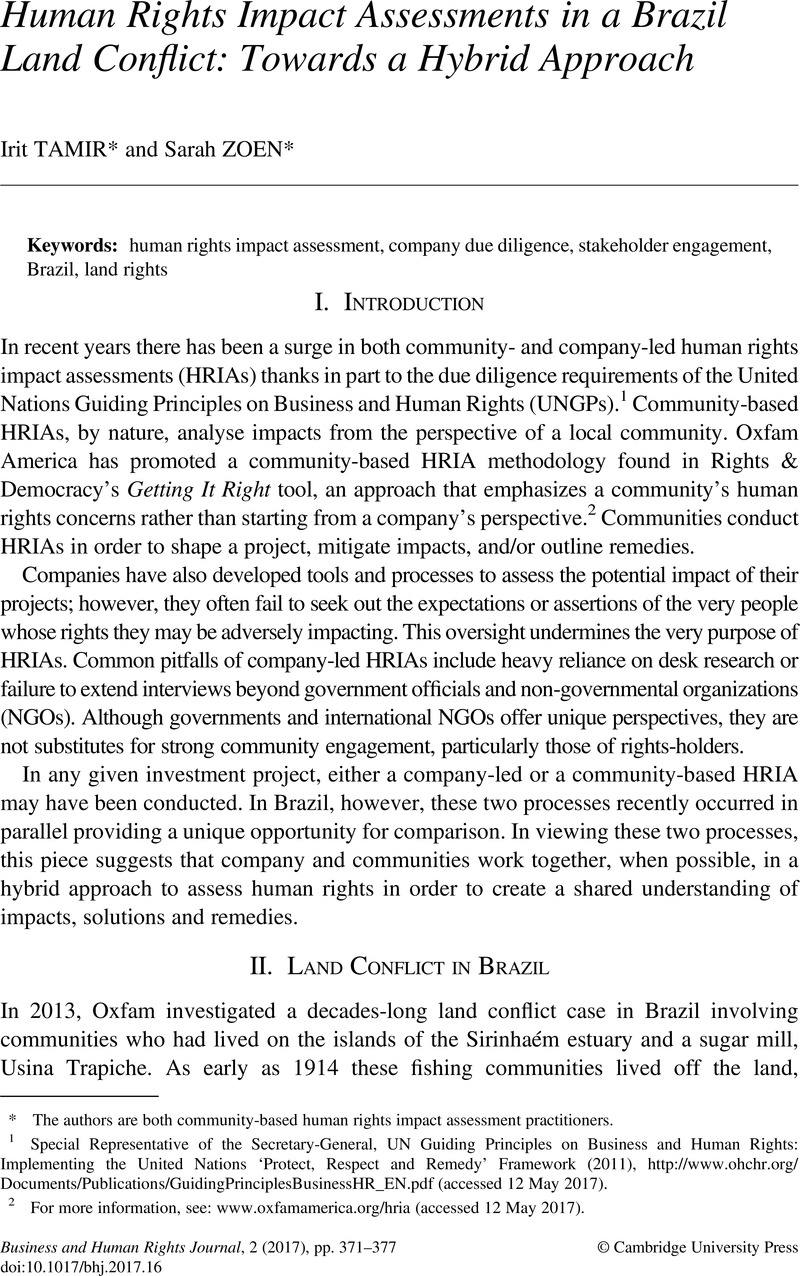Published online by Cambridge University Press: 19 June 2017

The authors are both community-based human rights impact assessment practitioners.
1 Special Representative of the Secretary-General, UN Guiding Principles on Business and Human Rights: Implementing the United Nations ‘Protect, Respect and Remedy’ Framework (2011), http://www.ohchr.org/Documents/Publications/GuidingPrinciplesBusinessHR_EN.pdf (accessed 12 May 2017).
2 For more information, see: www.oxfamamerica.org/hria (accessed 12 May 2017).
3 L Schneider (2010), ‘A Sweeter Alternative for Whom?’, available at: https://www.american.edu/sis/gep/upload/LynnSchneider_SRP_Final_1.pdf (accessed 23 May 2017).
4 RESEX is Reserva Extrativista in Portuguese. A RESEX is a protected land reserve that is publically owned but gives the local community the right to access the area and continue its traditional practices living off the land.
5 Comissão Pastoral da Terra (2016), ‘Starving to Death Little By Little Every Day’, available at: https://www.cptne2.org.br/downloads/pdf/dossie_sirinhaem_ingles.pdf (accessed 20 March 2017).
6 CPT applied the Getting it Right human rights impact assessment methodology that Oxfam promotes. More information can be found at www.oxfamamerica.org/hria (accessed 12 May 2017).
7 See Note 5.
8 Ibid. For a full list of interviewed groups, see p. 123.
9 Ibid, p. 9.
10 Ibid, p. 101.
11 Based on Oxfam interview with the Pastoral Land Commission (2013). See also Amnesty International video: http://www.youtube.com/watch?v=OMzIshWJgOw (accessed 12 May 2017); and L Schneider (2010), ‘A Sweeter Alternative for Whom?’, available at: https://www.american.edu/sis/gep/upload/LynnSchneider_SRP_Final_1.pdf (accessed 23 May 2017).
12 Food and Agriculture Organization of the United Nations: http://www.fao.org/economic/est/est-commodities/sugar/en/ (accessed 1 May 2017).
13 The Coca-Cola Company Commitments Land Rights and Sugar (2015), http://assets.coca-colacompany.com/6b/65/7f0d386040fcb4872fa136f05c5c/proposal-to-oxfam-on-land-tenure-and-sugar.pdf and PepsiCo Land Policy (2015), https://www.pepsico.com/Assets/Download/PepsiCo_Land_Policy.pdf (both accessed 12 May 2017).
14 Coca-Cola called their assessment a baseline study and PepsiCo framed it as an audit. Neither company actually used the term Human Rights Impact Assessment.
15 Arch Advisors (2015), ‘Child Labor, Forced Labor, and Land Use in Brazil’s Sugar Industry’, http://www.coca-colacompany.com/content/dam/journey/us/en/private/fileassets/pdf/human-and-workplace-rights/TCCC-Brazil-Report.pdf (accessed 1 May 2017).
16 PepsiCo (2015), Summary Report of the Social, Environmental, and Human Rights aspects of PepsiCo’s Sugarcane Supply Chain in Brazil, based on Third Party Audits. See: http://www.pepsico.com/docs/album/policies-doc/pwp/pepsico-brazil-sugarcane-supply-chain-assessment.pdf?sfvrsn=0 (accessed 1 May 2017).
17 Ibid.
18 Arch Advisors (2015); see Note 15.
19 More information about Bonsucro available at: www.bonsucro.com
20 PepsiCo (2015). Summary Report of the Social, Environmental, and Human Rights aspects of PepsiCo’s Sugarcane Supply Chain in Brazil, based on Third Party Audits; see Note 16.
21 Ibid.
22 http://www.pepsico.com/Purpose/Policies (accessed 12 May 2017).
23 External evaluator was John Wilkinson, Associate Professor at the Graduate Center for Development, Agriculture and Society (CPDA), Rural Federal University, Rio de Janeiro (UFRRJ).
24 John Wilkinson, ‘Independent Evaluation of Land Issues in TCCC’s baseline study: Child Labor, Forced Labor and Land Use in Brazil’s Sugar Industry and in PepsiCo’s summary report: The Social, Environmental and Human Rights Aspects of PepsiCo’s Sugarcane Supply Chain in Brazil Based on Third Party Audits’, October 2016; available at: https://www.oxfam.org/sites/www.oxfam.org/files/file_attachments/rr-independent-evaluation-land-issues-brazil-201016-en.pdf (accessed 20 March 2017).
25 Coca-Cola: http://www.coca-colacompany.com/coca-cola-unbottled/land-rights-the-path-forward-on-coca-cola-s-sugar-studies and https://www.oxfam.org/sites/www.oxfam.org/files/bn-land-rights-soda-giants-brazil-201016-en.pdf. PepsiCo: http://www.pepsico.com/Purpose/Policies and https://www.oxfam.org/sites/www.oxfam.org/files/bn-land-rights-soda-giants-brazil-201016-en.pdf (all accessed 12 May 2017).
26 John Wilkinson (2016); see Note 24.
27 The company has already made commitments to make these improvements in future efforts. For more information, see: http://www.coca-colacompany.com/coca-cola-unbottled/land-rights-the-path-forward-on-coca-cola-s-sugar-studies and https://www.oxfam.org/sites/www.oxfam.org/files/bn-land-rights-soda-giants-brazil-201016-en.pdf (both accessed 12 May 2017).
28 This is a recommendation made by Oxfam, which was absent from the company and external evaluation analysis. Oxfam (2016), ‘Land Rights and Soda Giants, Reviewing Coca-Cola and PepsiCo’s land assessments in Brazil.’
29 The company has already made commitments to make these improvements in future efforts. For more information, see: http://www.pepsico.com/Purpose/Policies and https://www.oxfam.org/sites/www.oxfam.org/files/bn-land-rights-soda-giants-brazil-201016-en.pdf (both accessed 12 May 2017).
30 This is a recommendation made by Oxfam, which was absent from the company and external evaluation analysis. Oxfam (2016), ‘Land Rights and Soda Giants, Reviewing Coca-Cola and PepsiCo’s land assessments in Brazil.’
31 Oxfam America (2015), ‘Community Voice in Human Rights Impact Assessments,’ https://www.oxfamamerica.org/explore/research-publications/community-voice-in-human-rights-impact-assessments/ (accessed 20 March 2017).